How to Understand a Supplement Label
A formulation expert weighs in on everything you need to know to make an informed decision in the supplement aisle.

Photo by Innerbody Research
You’ve probably stood in a pharmacy and held two nearly identical supplements in your hands, both claiming to do the same thing, even though they may seem subtly different. How do you know which one is the better choice for your needs? It’d be nice if the label information was clear, concise, and immediately meaningful, but that's rarely the case.
With well over 100,000 supplement products on the market in the U.S., supplement manufacturers do everything they can to stand out, from making exaggerated marketing claims to creating fantastical names for relatively simple ingredients.1 In my professional role as a formulation expert, I guide clients toward the best combinations of ingredients to meet their customers’ needs. I can tell at a glance whether a supplement is well-made or trustworthy, and I want to show you how to cut through the noise and get the information you need to make a smart decision for your health.
To achieve this, we’ll need to dissect that little shiny little rectangle stuck to every supplement bottle, starting with the first thing you’re likely to see.
The front of the label
Whether you pick up a bottle in a pharmacy or land on a product page online, the front of the label is typically the first thing you see, and it contains a combination of basic, straightforward information and marketing language. Knowing the difference is critical.
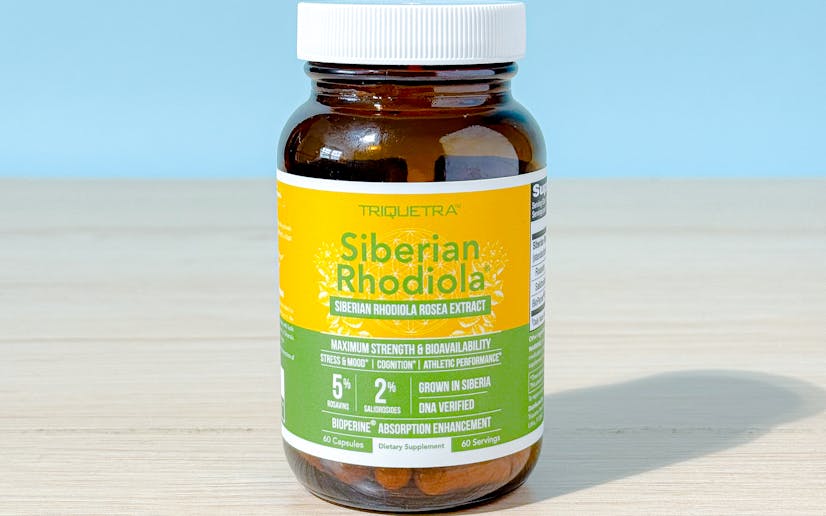
Photo by Innerbody Research
Take a look at this label from a bottle of Triquetra’s Rhodiola rosea extract. It’s got a pretty common combination of useful information and marketing claims on it. Among the more useful bits of information are:
- Brand name: Triquetra
- Product name: Siberian Rhodiola rosea extract
- Supplement count and format: 60 capsules
- Extract standardization info: 5% rosavins, 2% salidrosides
- Indication of added ingredients: “BioPerine Absorption Enhancement”
- Indication of serving size: 60 servings
But there’s also a lot of marketing material here that can be both helpful and harmful. Let’s examine it:
Compared to what? Other Rhodiola extracts? A kids’ vitamin? I happen to know from my research that this product is among the higher concentrations of its standardized extract components, but only a fraction of potential customers would have done that research. So it’s a legitimate claim, but it’s hard to verify and serves to promote more than to inform.
This kind of language can help you identify a potential application for a given supplement. There are studies supporting Rhodiola’s role in these areas, but much of it is animal research, with only ten or so human trials into something like physical and mental fatigue currently available.2 As such, this kind of claim should be taken with a grain of salt until you can do some digging.
This is pretty meaningless. A tremendous amount of Rhodiola is grown in Siberia, as it’s native to northern latitudes across Europe and Asia.3 It’s possible the company is trying to create a sense of ruggedness here, to give potential customers the sense that they can be rugged, too. It contributes to a “cool factor” but isn’t grounded in science.
More meaningless marketing jargon. Verified for what? The fact that it’s Rhodiola in the first place? Its Siberian origin? Or did they just submit some Rhodiola to Ancestry.com and fill out its family tree? It sounds fancy, but it’s not important at all.
To be fair, Triquetra is among the better companies for its manufacturing practices, ingredient quality, and doses. Even its marketing language is relatively mild, and few companies are immune to marketing necessities altogether.
What’s legal to put on a label?
You may wonder if there’s a limit to what a company can claim on its label. There is, but it’s not that strict; it varies greatly from country to country, and in the U.S., you’re allowed to say quite a lot.4
Now, this does depend on the ingredient you’re using, and manufacturers (the companies physically making the product, often different from the companies/brands selling them) will have some input here. Even the most lax manufacturer signing off on your label is going to hesitate to let a company claim that a vitamin C supplement can make you grow a foot taller overnight (hint: It can’t). However, I have still seen some very interesting claims make their way onto a finished product label.
For example, a top-selling greens powder (no, not that one, but another one) used to have a big, reassuring check mark on the front of its label with some tiny writing around it that you couldn’t really see from afar. It looked like some important organization had signed off on the product as being healthy.
Want to know what the tiny writing said?
“Great tasting, approved by [Founder’s Name]’s Mom.”
They sold millions of units over many years before they eventually updated their label (I’m not sure if that was to be more ethical or to avoid a lawsuit, but I guess we’ll never know).
This is why I implore you to put on your skeptic’s hat when reading all claims made on a product’s front label.
Of course, the best thing you could do from there is to turn the bottle over (or swipe to the next image on a given website) and scrutinize the Supplement Facts.
The Supplement Facts
The panel of a supplement label that most clearly delineates a product’s contents is called the Supplement Facts, beneath which you’ll find more useful and highly policed information than you’ll see anywhere else. The data points under Supplement Facts include:
- Serving size
- Number of servings per container
- Pharmacologically relevant ingredients and their doses per serving
- Other ingredients included in the product
- Percentage of daily value for individual ingredients where applicable
This is also the part of the label where you may encounter things like serving suggestions, storage guidelines, health warnings, and brand information such as company contacts, though you may also find these on the third panel, which I’ll get into later.
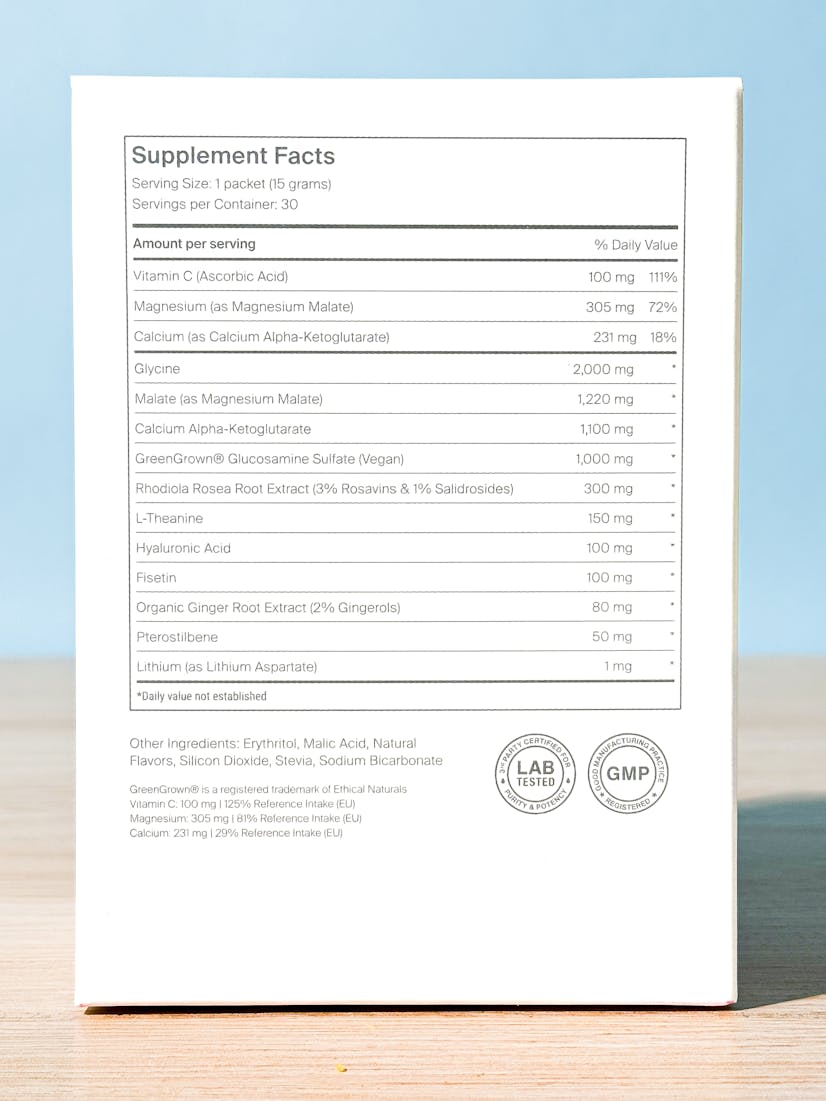
Photo by Innerbody Research
Understanding the nuances of this label area can make it readily apparent whether a supplement is worth your time and money, so let’s break down each segment further. To do this, we’re going to use a Supplement Facts label from a longevity company called NOVOS. Specifically, we’re looking at the label for NOVOS Core, the company’s anti-aging drink mix.
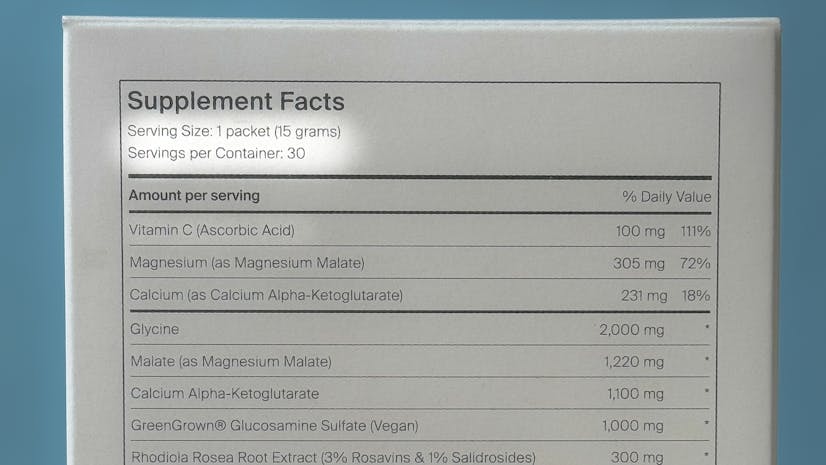
Photo by Innerbody Research
The first things you’ll see under the Supplement Facts title are the serving size and servings per container. In this case, NOVOS divides its drink mix into single-serving packets, so one serving is one packet. Each box contains 30 packets — a one-month supply.
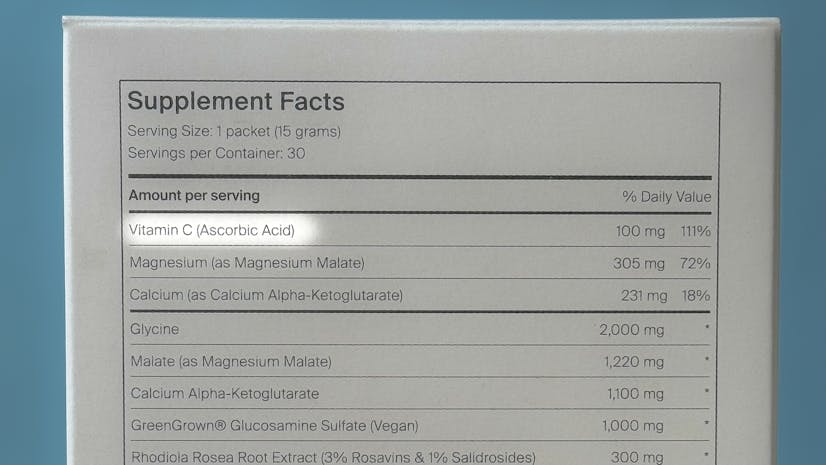
Photo by Innerbody Research
Beneath that, there are typically three columns of information: Ingredient, Dose, and % Daily Value (DV). For example, the first ingredient listed here is vitamin C, which we're all probably familiar with. But suppose you’re looking for a supplement to perform a certain task in your life, and the one you pick up claims it can do this but contains ingredients that you’re not familiar with. In that case, you should do at least a little research.
Google Scholar is an excellent source for finding published, peer-reviewed research. There are also some trustworthy sites out there associated with certain clinics and universities that can provide you with good information. And, of course, you’ve already arrived at a great resource for trustworthy information: the guides here on Innerbody Research.
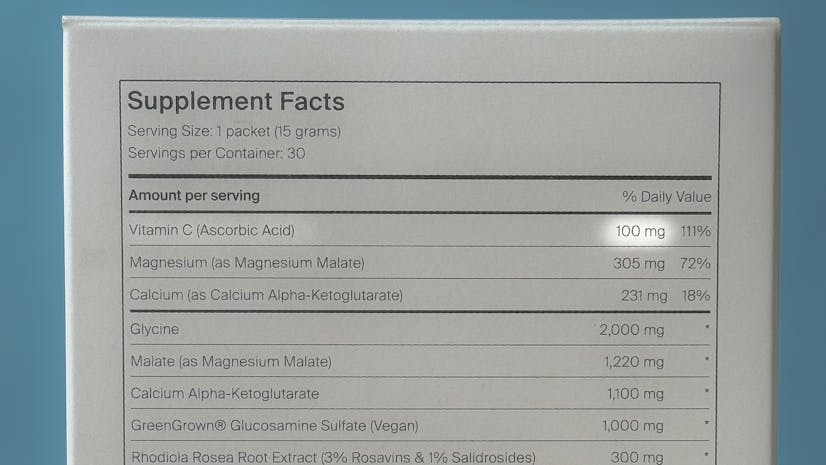
Photo by Innerbody Research
The vitamin C dose is 100mg. For NOVOS’ purposes, this is a good dose.5 But not all supplements provide ingredient doses that align with scientific research. In fact, many will underdose ingredients, which may keep the serving size lower — and make the products less expensive to produce, package, and ship — while allowing a company to market around the valuable ingredients included in the formula. In those cases, your best hope is that the combination of low-dose ingredients will produce a result greater than the sum of its parts.
As I mentioned above, a small amount of research can help you discover what scientific studies in humans say is likely to be an effective dose for a given ingredient to perform a specific task.
For example, if you take some time to look through studies of L-theanine supplementation in humans, you’ll find a recurring theme of 200mg.6
So, if you pick up a label and you see it has just 50mg of L-theanine, it’s probably not going to help you get the result you’re after. However, if it has 200mg per serving, it’s far more likely to deliver for you.
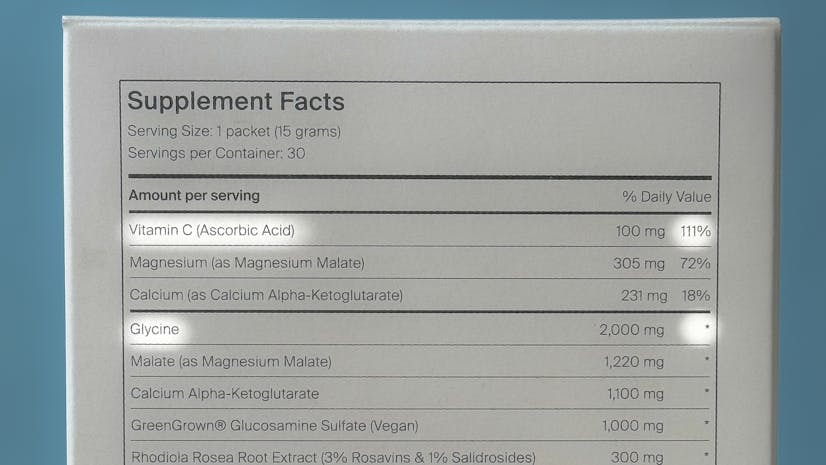
Photo by Innerbody Research
Finally, the % DV of Vitamin C in NOVOS Core is 111%, meaning that the supplement contains more than your entire daily requirement for vitamin C. With water-soluble vitamins like C and the Bs, you can take a little more than 100% DV safely, as your body will expel through your urine what it doesn’t need. (Though it’s important to note that megadoses — thousands of times the recommended daily value — can create imbalances and other problems.)
The FDA is responsible for setting DVs as amounts ideal to prevent deficiency, and it usually doesn’t set them for botanical ingredients.7 Even some minerals and amino acids don’t have a recommended DV, often due to a lack of research or a general perception of safety, even at large doses.
In the image above, you can see that vitamin C has a % DV listed, but glycine — an amino acid — does not.
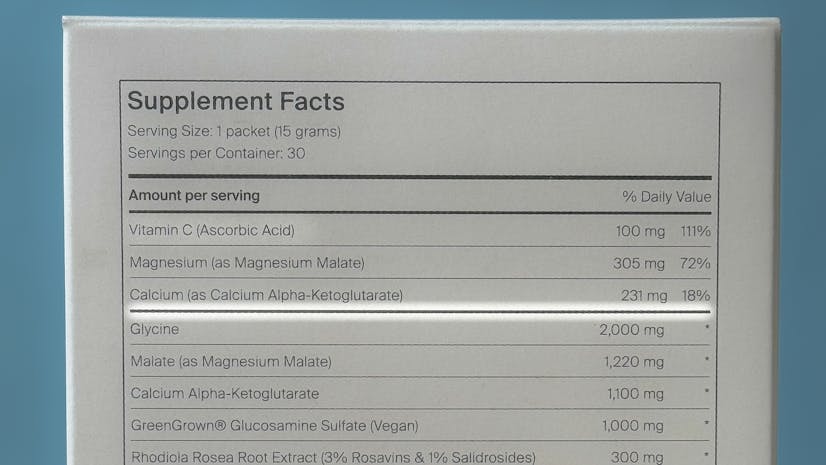
Photo by Innerbody Research
More often than not, vitamins and minerals appear toward the top of the list under Supplement Facts, with other pharmacologically active ingredients (botanicals, amino acids, etc.) appearing beneath those, often with a slightly thicker horizontal line dividing the sections, as seen above.
But sometimes, ingredient information related to a vitamin or mineral above that line crosses over with information beneath it. For example, NOVOS Core lists 231mg of calcium, with a parenthetical next to it that reads “from Calcium Alpha-Ketoglutarate.” Then, below the line, you can see the label also lists 1,100mg of calcium alpha-ketoglutarate.
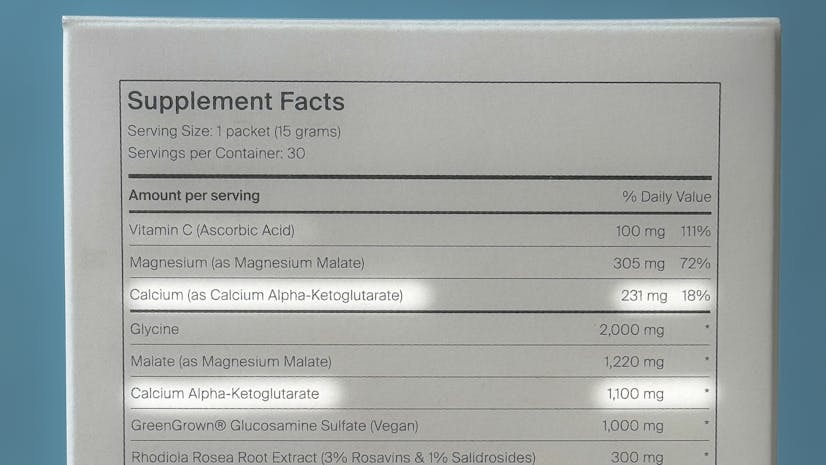
Photo by Innerbody Research
Does that mean that there’s 231mg of the one and 1,100mg of the other, totaling some 1,331mg combined? Nope! It actually means that the 231mg of calcium in NOVOS Core is the amount of elemental calcium — the mineral itself — derived from 1,100mg of calcium alpha-ketoglutarate.
But what’s the difference between calcium and calcium alpha-ketoglutarate? To understand that, you have to look closely at how ingredient information is conveyed on a label.
Understanding supplement label ingredients
The ingredients listed under Supplement Facts can tell you nearly everything you need to know about the potential of a supplement to deliver on its promises. But there are a lot of nuances to consider, from the specific forms of ingredients included to the complexities of extracts. Let’s start out by addressing the question I posed earlier regarding calcium alpha-ketoglutarate.
Chelated minerals and vitamin forms
Calcium alpha-ketoglutarate, or CAKG, is a chelated form of calcium. It’s a combination of calcium and another substance that makes it easier to absorb. If you just chewed on some raw calcium, very little of it would get into your bloodstream. In some cases, the substances used in chelation also stabilize minerals, making them safer and more shelf-stable.
So, NOVOS Core contains 1,100mg of CAKG, 231mg of which is raw, elemental calcium and 869mg of which is alpha-ketoglutaric acid. There are other chelating agents used in calcium production, but CAKG is among the best for absorption.
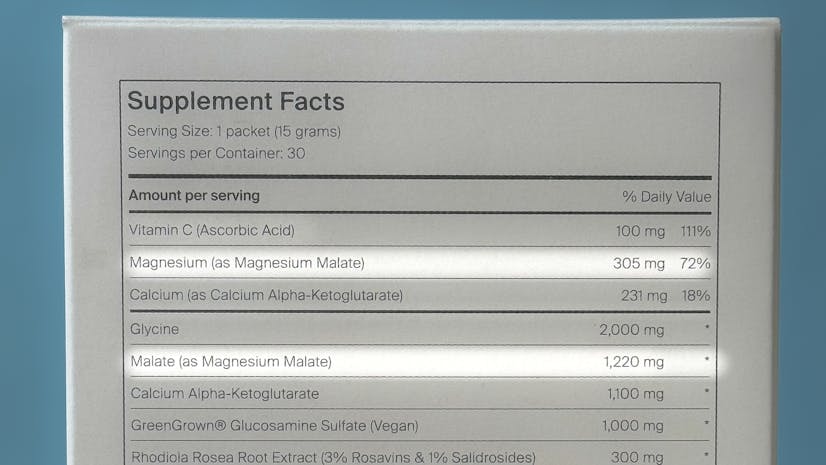
Photo by Innerbody Research
Core also contains 1,700mg of magnesium malate comprising 304mg of magnesium and 1,396mg of malic acid.
You’ll see a similar story play out among vitamins, but instead of affecting the actual amount of an elemental vitamin you get, different vitamin forms can have specific effects and side effects. For example, there are several forms of vitamin B3, including both niacin and nicotinamide riboside (NR). Niacin still imparts benefits, including for things like cardiovascular disease,8 but it’s been known to cause some skin flushing that can be uncomfortable. NR, on the other hand, has much more research indicating a direct relationship with mitochondrial health, energy levels, and healthy aging, and it doesn’t appear to cause the same degree of flushing.9 Both are B3, but they act very differently.
This is why it’s important to see what forms of a given vitamin or mineral are in use on a supplement label. If the information isn’t there (e.g., it says “Vitamin B3” but doesn’t specify further), it’s time to contact customer service. If you can’t get an answer, you should avoid the supplement.
What exactly is an extract?
Botanical supplements are almost always available in powder or extract form, but this can get confusing quickly, especially when you realize that liquid extracts can be dehydrated and turned into a powder!
So, what is an extract, and when should you reach for one over a whole, powdered form?
The first part of that question has a simple answer and a much more complex answer. Simply put, an extract is a concentrated form of the bioactive compounds in a given plant.10 The more complicated answer involves discussing the means by which those compounds are extracted and concentrated.
Let’s use broccoli as an example. If you’re into healthy eating, you might know that it’s better to steam broccoli than to boil it, and it’s better to bake broccoli than to steam it. That’s because boiling or steaming broccoli allows nutrients to be released from the broccoli itself and enter the water in the pot. You then eat the broccoli but pour those nutrients down the drain. In a rudimentary sense, that broccoli-infused water is a kind of very weak extract.
At the opposite end of the spectrum, you’ll find sulforaphane supplements, extracts of broccoli seed that are highly refined to provide a specific phytonutrient found in broccoli.11 It’s a very difficult compound to extract; no amount of simple boiling water will do the trick.
This is also a good example of when you'd want an extract over a powdered whole plant. The amount of powdered broccoli it would take to deliver a dose of sulforaphane equivalent to what you'd get from an extract would probably cause your stomach to explode.
Extract ratios and conversion to powder equivalents
Ingredient labels will sometimes point out a specific extract ratio used in creating a given extract. That ratio conveys how much plant material is packed into a single unit of extract. Here’s how it breaks down:
| Extract ratio | Dose | Plant material equivalent |
|---|---|---|
| 10:1 | 100mg | 1,000mg (1g) |
| 20:1 | 500mg | 10,000mg (10g) |
Things can get a little hairy when companies try to convey their extract doses in a way that gets you to think they have more of an ingredient in their formula than they really do. For example, KSM-66 branded ashwagandha is roughly a 10:1 extract. Studies show that 600mg of this extract is an effective dose for anxiety and stress.12 At 10:1, that 600mg dose equals 6,000mg of raw plant material.
Unscrupulous companies might try to sneak one past you by putting 60mg of the 10:1 extract in there, which would only equal 600mg of raw plant material, whereas all the research relates to the larger 600mg dose of the extract, not the raw material. Still, companies might try to claim that they have a clinically relevant dose just because they can do some creative accounting and sneaky writing to suggest their product contains 600mg of ashwagandha.
In some cases, you’ll encounter the opposite, when a majority of the research looks into raw plant material, but the market offers numerous extracts. In that case, you’ll want to find an extract with a listed ratio you can convert to see if it matches the clinical dose.
If you’re unsure about the extract dose a company is trying to convey on its label, it’s best to contact customer service.
Extract standardization: Does it matter?
Some extracts are standardized to contain a specific percentage of the bioactive compounds associated with their health benefits. I always encourage consumers to seek out standardized extracts because they can provide exact doses of the most important parts of an extract.
Imagine two extracts from the same plant — let’s call it Mustanious sallinicus, or Mustang Sally for short. One label says its Mustang Sally extract is standardized to 10% ridearounds (a fake phytonutrient), and the other doesn’t say one way or another.
Well, you can rest assured that 100mg of the standardized Mustang Sally will provide 10mg of ridearounds. But the other extract could provide any quantity of ridearounds. And each capsule in a bottle could be different. That could decrease the chances of efficacy AND increase the risk of side effects if the extract were too potent.
If you can find a standardized version of the extract you’re seeking, it’s often the best place to start.
Are branded ingredients worth it?
Sometimes, companies take pains to develop a version of an ingredient that has unique properties. It might be an extract with a greater standardized concentration of active compounds than any other on the market. Or it could be a powder that’s undergone a special micronization process to make it easier to absorb. These ingredients often show up with special names and little symbols next to them indicating a copyright.
Branded ingredients aren’t automatically better than unbranded ingredients, but they can give you a research advantage. Often, branded ingredients have published scientific research associated with them, which can elevate your level of confidence in a given product. It costs more to include these ingredients, but if there’s more science supporting them than unbranded versions of the same substances, they could very well be worth it.
Ashwagandha — a botanical ingredient shown to reduce stress, raise testosterone, and improve sleep — is a great example. There are studies looking into its powdered forms, as well as various extracts. Three branded extracts dominate the market: Sensoril, KSM-66, and Shoden.
The key with ashwagandha extracts is in isolating and promoting the presence of withanolides, a group of compounds that research has identified as being the most important aspects of ashwagandha’s efficacy.13 There’s also a question of which plant part the withanolides come from — Sensoril extracts its withanolides from the root and the leaf, while KSM-66 and Shoden focus on the root.
Here are their respective strengths:
- Sensoril: Contains up to 10% withanolides
- KSM-66: Contains at least 5% withanolides
- Shoden: Contains 35% withanolides
Different studies have shown some similar and competing effects among these extracts, with KSM-66 being the most widely studied of the bunch. Shoden may be too strong for some people, but its strength is noteworthy for people who need it. And Sensoril could prove a nice middle ground between KSM-66 and Shoden, though its use of both root and leaf may dilute its ultimate effectiveness.
The key with branded ingredients is to look them up specifically, find out if they’re actually any different from unbranded options, and scrutinize the relevant research.
What’s in a proprietary blend?
Some supplement labels conceal more than just the underlying form of an ingredient. Sometimes, they leave out information as important as the exact dose, as well. For one reason or another, some companies will create what they typically call “proprietary blends” of ingredients. They may give you a dose for the blend itself, but they usually won’t say how much of each ingredient is present in the blend. Those individual doses remain a mystery.
Insider Tip: Ingredients in proprietary blends are listed in order by weight from heaviest to lightest. That means the first ingredient is more abundant than the second, the second more abundant than the third, and so on. If the entire weight of a blend is, say, 500mg, but you know that 500mg is the minimum effective clinical dose of any ingredient in the blend, you can be confident that this blend will not work for you.
Proprietary blends aren’t inherently bad — sometimes they protect legitimately valuable intellectual property — but because they make it difficult to ascertain exactly what you’re taking, it’s smarter to seek out supplements with greater transparency.
The “other” ingredients
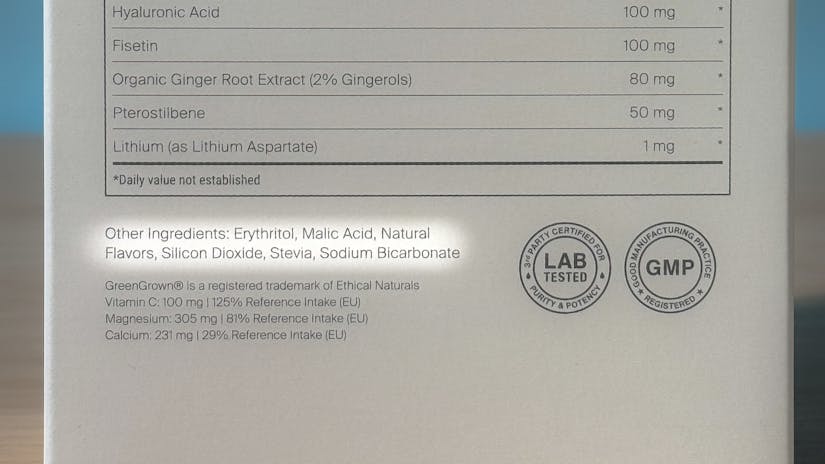
Photo by Innerbody Research
Beneath the Supplement Facts, you’ll find what’s usually a short list of “other” ingredients. To qualify for this list, an ingredient has to have no direct pharmacological purpose in a given formula. This is usually where you’ll find things like the materials that make up the capsule and any stabilizers added to increase shelf life.
However, with some supplements, especially those you drink, this is where you can find things like the source of sweetness (e.g., cane sugar, stevia, monk fruit, etc.), flavor or color additives, and extra preservatives.
It’s important to look over this section of the label to ensure you’re getting something that’s safe and that you’ll enjoy. If you’re among the many people who are hyper-sensitive to stevia and you’ve ever bought a drink without realizing it was in there, you know the importance of checking beforehand.
Comparing two labels claiming to do the same thing
To tie all of these points together, let’s compare two ingredient labels for a pair of testosterone booster supplements. I’ll leave out brand and price information here and focus on the ingredients themselves.
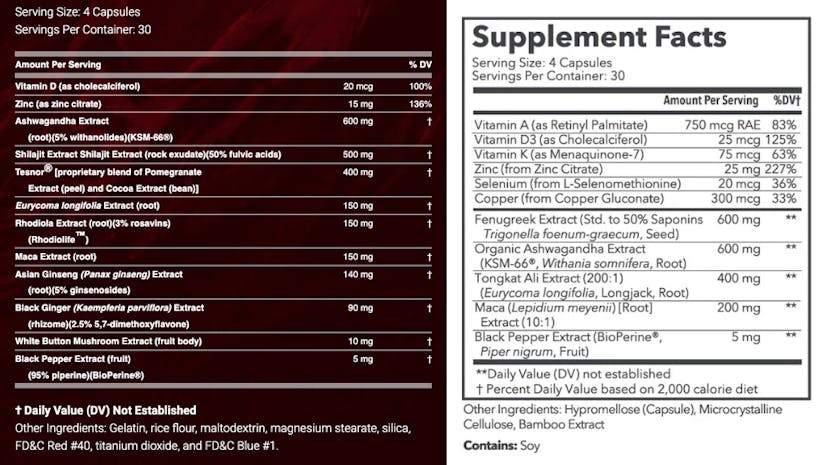
Photo by Innerbody Research
Let’s refer to the facts on the left as the Red supplement and the facts on the right as the White supplement.
Working from the top down, you can see that both products have a four-capsule serving size and deliver 30 servings per bottle. The next thing you’re likely to notice is that the White supplement has more vitamin and mineral content than the Red, with six such ingredients versus two.
If you stopped to do a little research into these vitamins and minerals, you might learn that vitamin K helps with the metabolism of vitamin D, allowing what’s already a higher dose of D in the White supplement to be more effective.14 You might also discover that copper deficiency is a risk of zinc supplementation, so the combination of copper and zinc in White should be safer than the zinc on its own in the Red supplement.15 So far, advantage White!
Moving into the botanicals, you can see that Red’s ingredients outnumber those of White by a score of 10-5. On the surface, that looks like a clear win for Red, right?
Not so fast! Of its ten botanicals, Red includes only four that are present at clinically relevant doses: ashwagandha, shilajit, Tesnor, and black pepper extract. By comparison, all five of the botanicals in White are present at clinically relevant doses that studies suggest should work. And of the ingredients that the products share, White either has as much or more in every dose. Again, advantage White.
Looking beneath the main ingredients, you’ll see that Red contains gelatin, making it unsuitable for vegans and vegetarians. It also contains two artificial colors in its capsules, which many may want to avoid. By comparison, White contains soy, which is an allergen for some, but its capsule is vegan-friendly and free of artificial colors. Advantage White by a hair!
So, at first glance, Red looks more impressive, with its longer list of ingredients. But the specific ingredients and doses in White should make it both safer and more effective for most men looking to boost testosterone.
Certifications
Certifications serve multiple purposes for supplement companies. They can reassure customers that a product does or does not contain something the customers want to access or avoid. They can also show customers that a company takes certain steps to ensure the safety of its products and even to manage its impact on the planet or local communities associated with the product’s manufacture.
Here’s a quick rundown of some common certifications:
- Organic: uses only organically grown ingredients and components
- Non-GMO: contains no genetically modified organisms (organic products are inherently non-GMO in the U.S.)
- Vegan: contains no animal products or byproducts
- B-Corp: the company exhibits a vetted commitment to sustainability
- Informed Sport: contains no substances banned by the World Anti-Doping Agency
- Informed Choice: subjected to some of the most rigorous third-party testing available
Meeting a certifying organization’s standards is only one part of the certification process. Certifications cost money, so supplement companies have to pay to have their products tested or their supply chains vetted. That’s why some will say they’re vegan or organic without being certified. That doesn’t necessarily mean the product is inferior, but it does mean that certification can provide additional peace of mind, especially when you’re comparing two products against each other.
The third panel
Supplement labels usually consist of three panels. There’s the front, which we’ve covered, and the Supplement Facts, which we’ve covered, as well. But the third panel is more of a playground for the supplement company to do some more marketing. While it sometimes includes information about suggested use, storage, health warnings, and other things often seen alongside the Supplement Facts, it’s more often than not a place where companies elaborate on their supplement’s abilities.
As with marketing claims on the front of the label, statements on the third panel that don’t directly concern suggested use, warnings, certifications, and other relevant information we’ve already discussed can likely be ignored. It’s true that some upstanding companies will use this space to elaborate on the health claims made at the front of the label by referencing specific studies or providing other useful evidence. But this panel of the label undergoes the least policing of the three, making it the one you should take with the largest grain of salt.
When to contact customer service
Customer service quality may vary wildly from one supplement company to the next. Some have multiple lines of communication, including live chat, email, and phone support. Some of them text over WhatsApp. And others offer little more than a mailing address from which you may never hear back.
But if the product you're interested in has customer service to offer, when should you actually go through the effort to contact them?
There are any number of ways an ingredient label can lack clarity. Doses can hide within a complex proprietary blend, extracts could lack standardization or ratio information, and the forms of certain ingredients, like minerals, can go unspecified. Any time you’re unsure about the dose or nature of an ingredient, you should reach out to customer service.
Return and refund policies aren’t typically listed on bottles, but some companies will use their label’s front or third panel to advertise a money-back guarantee. If you want clarity on these policies before you buy, you probably need to contact customer service or at least investigate the company’s FAQ or Terms & Conditions pages online.
Supplement label red flags
No sector of the supplement space is free of the occasional bad actor. The loose marketing regulations in the U.S. make this problem that much worse. So, let’s review some red flags that, if you see them on a supplement label, might tell you to put the bottle back down.
Any time a label claims it can “cure” an ailment or that it poses no risk of side effects, you can confidently say it’s not worth your time.
If your research reveals that certain ingredients common to a given supplement category have a high risk of side effects, and you find those ingredients in a proprietary blend that makes it impossible to even guess at their dose, you should avoid that product. It’s not worth the risk.
Megadoses might be more of an orange flag, as they’re common among water-soluble vitamins and may not pose much of a risk in that space. But extreme doses of ingredients that research shows can work at much lower doses are definitely signs you should hesitate.
Final takeaway
Supplement labels can get complicated quickly, and there’s a lot of information to absorb and a bounty of research to do before you can make an informed decision. It can be helpful to find a reputable, reliable research organization to do some of this legwork for you, like Innerbody Research. Most importantly, talk to your doctor before adding any new supplement to your regimen, and never be shy about contacting customer service when you have questions.
Sources
Innerbody uses only high-quality sources, including peer-reviewed studies, to support the facts within our articles. Read our editorial process to learn more about how we fact-check and keep our content accurate, reliable, and trustworthy.
U.S. Food & Drug Administration. (2024). FDA’s regulation of dietary supplements with Dr. Cara Welch. FDA.
Ishaque, S., Shamseer, L., Bukutu, C., & Vohra, S. (2012). Rhodiola rosea for physical and mental fatigue: A systematic review. BMC Complementary and Alternative Medicine, 12, 70.
Panossian, A., Wikman, G., & Sarris, J. (2010). Rosenroot (Rhodiola rosea): Traditional use, chemical composition, pharmacology and clinical efficacy. Phytomedicine, 17(7), 481-493.
U.S. Food & Drug Administration. (2024). Dietary supplements guidance documents & regulatory information. FDA.
German Nutrition Society (DGE). (2015). New reference values for vitamin C intake. Annals of Nutrition & Metabolism, 67(1), 13-20.
Evans, M., McDonald, A. C., Xiong, L., Crowley, D. C., & Guthrie, N. (2021). A randomized, triple-blind, placebo-controlled, crossover study to investigate the efficacy of a single dose of AlphaWave® L-theanine on stress in a healthy adult population. Neurology and Therapy, 10(2), 1061.
U.S. Food & Drug Administration. (2024). Daily Value on the Nutrition and Supplement Facts labels. FDA.
National Institutes of Health. (2022). Niacin: Fact sheet for health professionals. U.S. Department of Health and Human Services.
Mehmel, M., Jovanović, N., & Spitz, U. (2020). Nicotinamide riboside — the current state of research and therapeutic uses. Nutrients, 12(6), 1616.
Monagas, M., Brendler, T., Brinckmann, J., Dentali, S., Gafner, S., Giancaspro, G., Johnson, H., Kababick, J., Ma, C., Oketch-Rabah, H., Pais, P., Sarma, N., & Marles, R. (2022). Understanding plant to extract ratios in botanical extracts. Frontiers in Pharmacology, 13, 981978.
Nandini, D. B., Rao, R. S., Deepak, B. S., & Reddy, P. B. (2020). Sulforaphane in broccoli: The green chemoprevention!! Role in cancer prevention and therapy. Journal of Oral and Maxillofacial Pathology: JOMFP, 24(2), 405.
Salve, J., Pate, S., Debnath, K., & Langade, D. (2019). Adaptogenic and anxiolytic effects of ashwagandha root extract in healthy adults: A double-blind, randomized, placebo-controlled clinical study. Cureus, 11(12), e6466.
White, P. T., Subramanian, C., Motiwala, H. F., & Cohen, M. S. (2016). Natural withanolides in the treatment of chronic diseases. Anti-Inflammatory Nutraceuticals and Chronic Diseases, 928, 329.
Masterjohn, C. (2007). Vitamin D toxicity redefined: Vitamin K and the molecular mechanism. Medical Hypotheses, 68(5), 1026-1034.
Duncan A, Yacoubian C, Watson N, and Morrison, I. (2015). The risk of copper deficiency in patients prescribed zinc supplements. Journal of Clinical Pathology, 68(9), 723-725.


